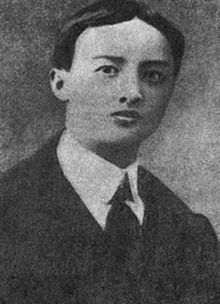- Martyrdom in Chinese culture
-
The concept of martyrdom in China was largely developed by the Tongmenghui and the Kuomintang party during the Xinhai Revolution, Northern Expedition, and Second Sino-Japanese War.
Modern Development
Revolutionaries of the Tongmenghui who died in attempts to overthrow the Qing dynasty were recognized as martyr's by the Republic of China after the Xinhai Revolution.
During the Xinhai Revolution itself, many Chinese revolutionaries became martyrs in battle. "Dare to Die" student corps were founded, for student revolutionaries wanting to fight against Qing dynasty rule. Dr. Sun Yatsen and Huang Xing promoted the Dare to Die corps. Huang said, "We must die, so let us die bravely".[1] During the revolution, suicide squads were formed by Chinese students going into battle, knowing that they would be killed fighting against overwhelming odds.[2] The 72 Martyrs of Huanghuagang died in the uprising that began the Wuchang Uprising, and were recognized as heroes and martyrs by the Kuomintang party and the Republic of China.[3] Dare to Die student corps led by men like Chiang Kaishek and Huang Shaoxiong with Bai Chongxi played a role in the attack against Qing forces in the Xinhai Revolution.[4][5] The martyrs in the Dare to Die Corps who died in battle wrote letters to family members before heading off to certain death. The Huanghuakang was built as a monument to the 72 martyrs.[6] The martyrdom of the revolutionaries helped the establishment of the Republic of China, overthrowing the Qing dynasty imperial system.[7]
"Dare to Die" corps continued to be used in the Chinese military. The Kuomintang used one to put down an insurrection in Canton.[8] Many women joined them in addition to men to achieve martyrdom against China's opponents.[9][10]
The Kuomintang continued to promote the concept of martyrdom, the souls of Party martyrs who died fighting for the Kuomintang and the revolution and the party founder Dr. Sun Yatsen were sent to heaven according to the Kuomintang party. Chiang Kaishek believed that these martyrs witnessed events on earth from heaven and he called on them for help.[11][12][13][14]
Coolies against the Communist takeover formed "Dare to Die Corps" to fight for their organizations, with their lives.[15] During the Tianamen Square Incident of 1989, protesting students also formed "Dare to Die Corps", to risk their lives defending the protest leaders.[16]
Islam
Islam has its own concept of martyrdom, which the Kuomintang promoted among Chinese Muslims through the Chinese Muslim Association. The Muslim General Ma Fuxiang stated on how Chinese Muslims were willing to die to accomplish tasks assigned to them.[17] Imams sponsored by the Kuomintang called for Muslims to go on Jihad to become shaheed (Muslim term for martyr) in battle, where Muslims believe they will go automatically to heaven. Becoming a shaheed in the Jihad for the country was encouraged by the Kuomintang, which was called "glorious death for the state" and a hadith promoting nationalism was spread.[18] A song written by Xue Wenbo at the Muslim Chengda school, which was controlled by the Kuomintang, called for martyrdom in battle for China against Japan.[19] The Muslim General Bai Chongxi himself was a member of a Dare to Die corps in the Xinhai revolution.[5]
References
- ^ Aul Linebarger (2008). Sun Yat Sen and the Chinese Republic. READ BOOKS. p. 263. ISBN 1443724386. http://books.google.com/books?id=51Fpis0D1v0C&pg=PA263&dq=dare+to+die+china&hl=en&ei=GeSrTOz6DYL48Aak3ZSzCA&sa=X&oi=book_result&ct=result&resnum=3&ved=0CDsQ6AEwAg#v=onepage&q=dare%20to%20die%20china&f=false. Retrieved 2010-06-28.
- ^ China yearbook. China Pub. Co.. 1975. p. 657. http://books.google.com/books?id=B_UnAAAAMAAJ&q=This+is+a+suicide+squad%3B+don't+come+with+us,+please.%22&dq=This+is+a+suicide+squad%3B+don't+come+with+us,+please.%22&hl=en&ei=_OOrTLfaGcL58AaBqIT0Bw&sa=X&oi=book_result&ct=result&resnum=1&ved=0CCUQ6AEwAA. Retrieved 2010-06-28.
- ^ Kai-shek Chiang (1968). Selected speeches and messages. Government Information Office. p. 21. http://books.google.com/books?id=Z5bpAAAAIAAJ&q=Yu+Pei-lun+martyr&dq=Yu+Pei-lun+martyr&hl=en&ei=6PmrTKXcKcG78ga7xtGSCA&sa=X&oi=book_result&ct=result&resnum=6&ved=0CEEQ6AEwBQ. Retrieved 2010-06-28.
- ^ Jay Taylor (2009). The generalissimo: Chiang Kai-shek and the struggle for modern China, Volume 39. Harvard University Press. p. 23. ISBN 0674033388. http://books.google.com/books?id=03catqbPCmgC&pg=PA23&dq=dare+to+die+china&hl=en&ei=GeSrTOz6DYL48Aak3ZSzCA&sa=X&oi=book_result&ct=result&resnum=6&ved=0CEkQ6AEwBQ#v=onepage&q=dare%20to%20die%20china&f=false. Retrieved 2010-06-28.
- ^ a b Howard L. Boorman, Richard C. Howard, Joseph K. H. Cheng (1979). Biographical dictionary of Republican China, Volume 3. New York City: Columbia University Press. p. 51. ISBN 0231089570. http://books.google.com/books?id=r3AJFusMHJwC&pg=PA51&dq=pai+ch'ung-hsi+dare+to+die&hl=en&ei=twYhTL27L8aqlAfXh9km&sa=X&oi=book_result&ct=result&resnum=1&ved=0CC4Q6AEwAA#v=onepage&q=pai%20ch'ung-hsi%20dare%20to%20die&f=false. Retrieved 2010-06-28.
- ^ Chün-tu Hsüeh (1961). Huang Hsing and the Chinese revolution. Stanford University Press. p. 93. ISBN 0804700311. http://books.google.com/books?id=hOeeAAAAIAAJ&pg=PA93&dq=dare+to+die+china&hl=en&ei=GeSrTOz6DYL48Aak3ZSzCA&sa=X&oi=book_result&ct=result&resnum=5&ved=0CEQQ6AEwBA#v=onepage&q=dare%20to%20die%20china&f=false. Retrieved 2010-06-28.
- ^ Free China review, Volume 14. W.Y. Tsao. 1964. p. 88. http://books.google.com/books?ei=RuSrTMyvM4G78gb7gM2vCA&ct=result&id=Wm7VAAAAMAAJ&dq=dare+to+die+china&q=It+was+the+martyrs%27+blood+which+paved+the+way+for+the+founding+of+the+Republic+of+China. Retrieved 2010-06-28.
- ^ Chiang Kai-shek (24 June 1957). "PART ONE CHIANG VERSUS COMMUNISM: HIS PERSONAL ACCOUNT". LIFE Magazine Vol. 42, No. 25: p. 147. http://books.google.com/books?id=IT8EAAAAMBAJ&pg=PA147&dq=dare+to+die+china&hl=en&ei=RuSrTMyvM4G78gb7gM2vCA&sa=X&oi=book_result&ct=result&resnum=3&ved=0CDkQ6AEwAjgK#v=onepage&q=dare%20to%20die%20china&f=false.
- ^ Marjorie Wall Bingham, Susan Hill Gross (1980). Women in modern China: transition, revolution, and contemporary times. Glenhurst Publications. p. 34. ISBN 0865960283. http://books.google.com/books?id=cZ3V9umMPf8C&q=Other+women+in+joining+the+%22Dare+to+Die%22+Regiments+later+on,+saw+her+as+a+model+for+rebellion+against+the+enemies+of+China.+One+of+her+last+poems+was+particularly+well-known+because+it+combined+the+themes+of+her&dq=Other+women+in+joining+the+%22Dare+to+Die%22+Regiments+later+on,+saw+her+as+a+model+for+rebellion+against+the+enemies+of+China.+One+of+her+last+poems+was+particularly+well-known+because+it+combined+the+themes+of+her&hl=en&ei=oeSrTLyiFIH68AanprijCA&sa=X&oi=book_result&ct=result&resnum=1&ved=0CCUQ6AEwAA. Retrieved 2010-06-28.
- ^ China review, Volume 1. China Trade Bureau, Inc.. 1921. p. 79. http://books.google.com/books?id=YYpIAAAAYAAJ&pg=PA79&dq=dare+to+die+china&hl=en&ei=GeSrTOz6DYL48Aak3ZSzCA&sa=X&oi=book_result&ct=result&resnum=7&ved=0CE4Q6AEwBg#v=onepage&q=dare%20to%20die%20china&f=false. Retrieved 2010-06-28.
- ^ Jieru Chen, Lloyd E. Eastman (1993). Chiang Kai-shek's secret past: the memoir of his second wife, Chʻen Chieh-ju. Westview Press. p. 236. ISBN 0813318254. http://books.google.com/books?id=IDbvAzXCBH8C&pg=PA236&dq=chiang+party+martyrs+heaven&hl=en&ei=9I-nTM0tw9-WB6bKzf0N&sa=X&oi=book_result&ct=result&resnum=7&ved=0CEcQ6AEwBg#v=onepage&q=%20party%20martyrs%20heaven&f=false. Retrieved 2010-06-28.
- ^ Hans J. Van de Ven (2003). War and nationalism in China, 1925-1945. Psychology Press. p. 100. ISBN 0415145716. http://books.google.com/books?id=dc7NOiTSgM0C&pg=PA100&dq=chiang+party+martyrs+heaven&hl=en&ei=9I-nTM0tw9-WB6bKzf0N&sa=X&oi=book_result&ct=result&resnum=3&ved=0CDIQ6AEwAg#v=onepage&q=chiang%20party%20martyrs%20heaven&f=false. Retrieved 2010-06-28.
- ^ Linda Chao, Ramon H. Myers (1998). The first Chinese democracy: political life in the Republic of China on Taiwan. Johns Hopkins University Press. p. 45. ISBN 0801856507. http://books.google.com/books?ei=LpCnTICmGILGlQe9hY3BDA&ct=result&id=LSS4AAAAIAAJ&dq=chiang+party+martyrs+heaven&q=and+those+martyrs+who+died+and+are+in+heaven.1+Chiang+warned+his+listeners+to+study+their+enemy%2C+the+Communists. Retrieved 2010-06-28.
- ^ Kai-shek Chiang. President Chiang Kai-shek's selected speeches and messages, 1937-1945. China Cultural Service. p. 137. http://books.google.com/books?ei=nJCnTNySHcWBlAfZmoG_DA&ct=result&id=TVNwAAAAMAAJ&dq=chiang+party+martyrs+heaven+President+Chiang+Kai-shek%27s+selected+speeches+and+messages%2C+1937-1945&q=and+the+revolutionary+martyrs+be+consoled+and+the+fervent+longings+of+millions+of+fellow-countrymen+be+satisfied. Retrieved 2010-06-28.
- ^ Kenneth Lieberthal (1980). Revolution and tradition in Tientsin, 1949-1952. Stanford University Press. p. 67. ISBN 0804710449. http://books.google.com/books?id=1Cs9_qeehaEC&pg=PA67&dq=dare+to+die+china&hl=en&ei=RuSrTMyvM4G78gb7gM2vCA&sa=X&oi=book_result&ct=result&resnum=6&ved=0CEYQ6AEwBTgK#v=onepage&q=dare%20to%20die%20china&f=false. Retrieved 2010-06-28.
- ^ Jan Wong (1997). Red China Blues: My Long March from Mao to Now. Random House, Inc.. p. 237. ISBN 0385256396. http://books.google.com/books?id=ng0Rr7FsoqQC&pg=PA237&dq=dare+to+die+china&hl=en&ei=GeSrTOz6DYL48Aak3ZSzCA&sa=X&oi=book_result&ct=result&resnum=8&ved=0CFIQ6AEwBw#v=onepage&q=dare%20to%20die%20china&f=false. Retrieved 2010-06-28.
- ^ Upton Close (2007). In the Land of the Laughing Buddha – The Adventures of an American Barbarian in China. READ BOOKS. p. 271. ISBN 1-4067-1675-8. http://books.google.com/books?id=DpQa22PJutwC&dq=arab+mercenaries+china&q=They+have+not+enjoyed+the+educational+and+political+privileges+of+the+Han+chinese%2C+and+they+are+in+many+respects+primitive#v=snippet&q=They%20have%20not%20enjoyed%20the%20educational%20and%20political%20privileges%20of%20the%20Han%20chinese%2C%20and%20they%20are%20in%20many%20respects%20primitive&f=false. Retrieved 2010-06-28.
- ^ Stéphane A. Dudoignon, Hisao Komatsu, Yasushi Kosugi (2006). Intellectuals in the modern Islamic world: transmission, transformation, communication. Taylor & Francis. p. 135. ISBN 00415368359. http://books.google.com/books?id=MJzB6wrz6Q4C&dq=ma+fuxiang+military+academy&q=anti+japanese#v=snippet&q=anti%20japanese%20hadith&f=false. Retrieved 2010-06-28.
- ^ Stéphane A. Dudoignon, Hisao Komatsu, Yasushi Kosugi (2006). Intellectuals in the modern Islamic world: transmission, transformation, communication. Taylor & Francis. p. 135. ISBN 00415368359. http://books.google.com/?id=MJzB6wrz6Q4C&pg=PA135&dq=china+jihad+japan+xue+chengda#v=snippet&q=chengda%20wrote%20a%20verse%20song%20hui%20japanese&f=false. Retrieved 2010-06-28.
Categories:- Martyrs
- Chinese culture
Wikimedia Foundation. 2010.

